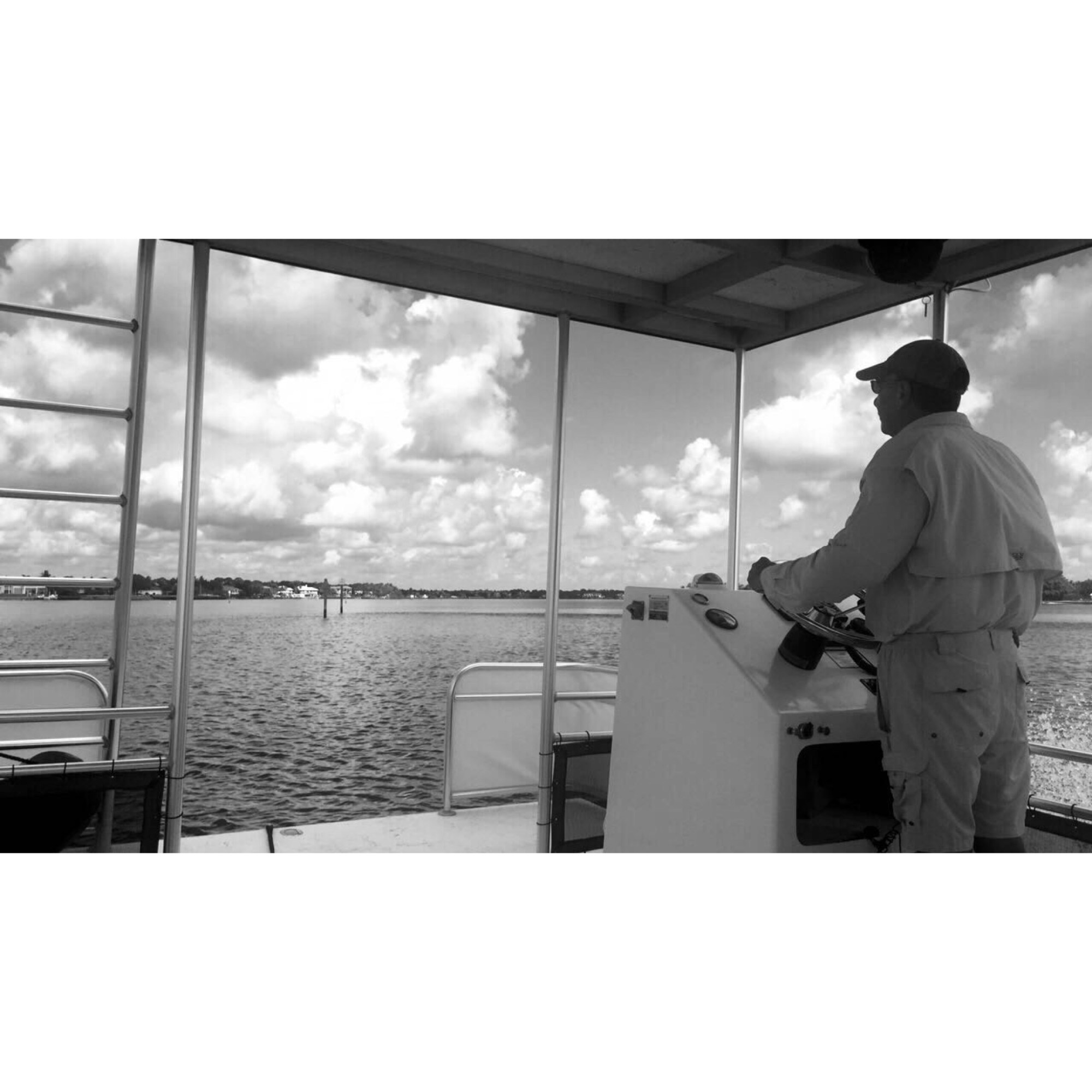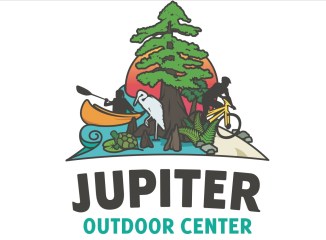From The Jetty To The Jungle

In the 8.5 mile stretch of the Loxahatchee River, the changes in the ecosystems along the way are enough to amaze anyone. In this relatively short distance; one can go from seeing jumping Dolphin and Tarpon, to sun bathing Alligators and Yellow-bellied Turtles. One moment you are riding along million dollar homes on crystal blue water and the next it almost feels like Jurrasic Park. The lush greenery causes the water to be darker due to the tanins in the fallen leaves, kind of like tea in hot water! The Loxahatchee River has supplied food, freshwater, and sanctuary to its nearby inhabitants for many years and continues to do so for its diverse species of animals. For this reason, it has become a popular attraction to travel up the river and back by small boat, kayak or canoe for a closer look at the plants and animals that live there. The other day was my first experience traveling up the river with our very own Captain John on the Jupiter Water Taxi Eco-tour. Although I was born here, and very much consider myself a Jupiter local, I never realized how truly spectacular this waterway was until I saw it for myself. The tour took us on a 4 hour ride focused mostly on the area and its history. I learned more from Captain John in 3 hours than I did in 3 weeks of history class! During high tide, The Jupiter Water Taxi takes guests from the Jupiter Inlet, all the way back to the mouth of the Loxahatchee or vice versa. The intimate atmosphere and limited seats make JWT the best way to learn about the area and discover new things. Captain John was able to focus all of his attention on our small group and made the experience unique for each guest. Sharing some of the amazing facts and history I learned on my tour with JWT will hopefully inspire you to take one for yourself!
Although the area has not been occupied as long as other parts of the country, Jupiter has an interesting history that largely revolves around the existence of the Loxahatchee River and Jupiter Inlet. It is said that when the Spanish first arrived, they named the area “Jobe” (Ho-Bay) after encountering the native tribe of the Jeagas, who called the area Hobe. This would later inspire the name for Hobe Sound. When the British arrived from the colonies, they translated the word to “Jove”, which in Latin refers to the Greek god Jupiter. Jupiter’s wife was called “Juno”, which led to the naming of Jupiter and its southern city, Juno beach. The name for Tequesta comes from a local Native American tribe called the “Tekesta’s”, whose name was translated when the Spanish arrived. They were a peaceful tribe that first settled near Biscayne Bay and built many other villages along the coastal islands. Some of the earliest documentation of Floridian Indian encounters comes from the journals of Jonathan Dickinson, a Quaker from Port Royal, Jamaica on his way to Pennsylvania. In 1696, Jonathan Dickinson and his family, along with crew members and slaves, were captured by Jeaga Natives after their ship wrecked off the coast of Florida. The Jeaga Indians inhabited much of what we know today as the Jupiter Inlet and were known to be one of the most violent tribes during the period. Surprisingly, the natives spared the lives of the Dickinson family and chose to free them. After giving most of what they had left to the tribe, they were let go where they walked and traveled by boat up the coast to St. Augustine. They would then find passage to their original destination where Dickinson would become Mayor of Philadelphia and write journals documenting his encounters with one of the first Floridian Native tribes.
Although these native tribes are important to the early history of the area, the most significant of all; then and today, are the Seminole Indians. The Seminoles inhabited many parts of Florida and can be traced back at least 12,000 years. Some evidence of this fact lies right on the edge of what is now Jupiter Farms. Riverbend Park is the site of two of the most relentless wars in Seminole history and still leaves traces of its presence today. More than 163 years ago, on May 17th, 1838, red and black Seminole Indians fought at Riverbend against U.S soldiers in an effort to maintain ownership of their lands and avoid being removed. In the end, 1500 American soldiers had died as well as large numbers of Seminoles and still, there would be no formal treaty signed between the groups. The wars left the Seminoles impoverished and forced them to find safe refuge in remote swampy areas. After the wars in 1838, American troops would construct the famous Fort Jupiter on Pennock Point to allow easier transport of goods and supplies for soldiers. After the third Seminole war in the 1850’s, Fort Jupiter would remain closed for good. It was located on what is now Old Fort Jupiter Rd.
Many decades later, the area would become more populated after the passing of the National Prohibition Act. This led many people to the still rural, “uninhabitable” areas of the South Florida. The Jupiter Inlet in particular was the perfect place to transport illegal boo’s, as the Bahamian Islands are a short 55 miles away. According to Betsy Dubois, “Rum Runners” would bring gunny sacks of liquor from the Bahamas through the Jupiter Inlet when the light was off or being maintained. Runners would sneak through the inlets darkened passageway and head north towards Jupiter Narrows to stash the alcohol where it would be transported at a later date. Others moved to Florida to escape the suffering society and return a state of nature. Vince “Trapper” Nelson was a polish immigrant from NJ that settled in Jupiter, FL in the 1930’s. Vince was a trapper, hunter, and zoo founder that would take residence on the shore of the Loxahatchee and make his living off the wild selling skins and meat. It is said that he could be seen wearing only a loin cloth, standing at over 6ft tall. Nelson became somewhat of an icon in the area and was called the “Wildman of the Loxahatchee”. Even women from Palm Beach would come to the island to gawk at him. In 1968, Trapper Nelson was found dead at his residence with a shotgun wound to the stomach. While his death was deemed a suicide, it is rumored that he may have been murdered, as he had acquired some enemies through his business. His compound is still open to visitors and provides a more in depth history about his life and experiences on the Loxahatchee. You can take a ride upriver with Captain John on a Cruise+, where he will drop you off to embark on a kayak adventure to the homestead of Trapper Nelson or pick you up there after your paddle downriver from Riverbend Park and bring you back to the Inlet Village.
The headwaters of the Loxahatchee River begin at the Loxahatchee slough, meandering through freshwater creeks, down into a brackish estuary, and finally emptying through the Jupiter Inlet and into the Atlantic Ocean. The river is a hub for history and a sanctuary for so many creatures, as it was left untouched for so many years. That is why in 1985, the river was named wild and scenic and is one of two, federally protected rivers in Florida. It is home to many rare and endangered species, such as the Sandhill Crane, Peregrine Falcon, Florida Manatee and the Woodstork. Common animals to see on the Jupiter Water Taxi Tour are Blue Heron, Egret, Osprey, Alligators, Yellow-bellied Turtles, and Manatees. With Captain Johns incredible eye, we were able to spot a Baby Alligator and Family of 3 Manatees as well as a Little Blue Heron. On our way back into the river, we saw an Osprey nest tucked safely in between signs and untouched mangrove islands that act as a nursery for young fish and other creatures. He also explained the harmful effects of erosion on the river and how many of the surrounding plants have had to adapt to the eroding shorelines over the years. The mangroves and mangrove islands help to keep the land from eroding as quickly, but it has become inevitable. He also informed us that you must have special permits to trim or cut mangroves as they are protected under the Mangrove Trimming and Preservation Act. Along the way you can also spot some of the famous celebrity properties in the area including Rickie Fowlers new home on Pennock Point and Michael Jordan’s upcoming restaurant on U.S. 1, North of Burt Reynolds Park. Captain John makes it his priority to teach everyone about the area and its history as well as the value of nature and respecting the environment. His degree in marine biology and his love for the area makes his tours informative and fun! He will take you back in time and show you an entirely different world on the Loxahatchee River. Thanks Captain John, It was an experience I will never forget!
For more information about Captain John and the Jupiter Water Taxi, Visit http://www.jupiterwatertaxi.com/

